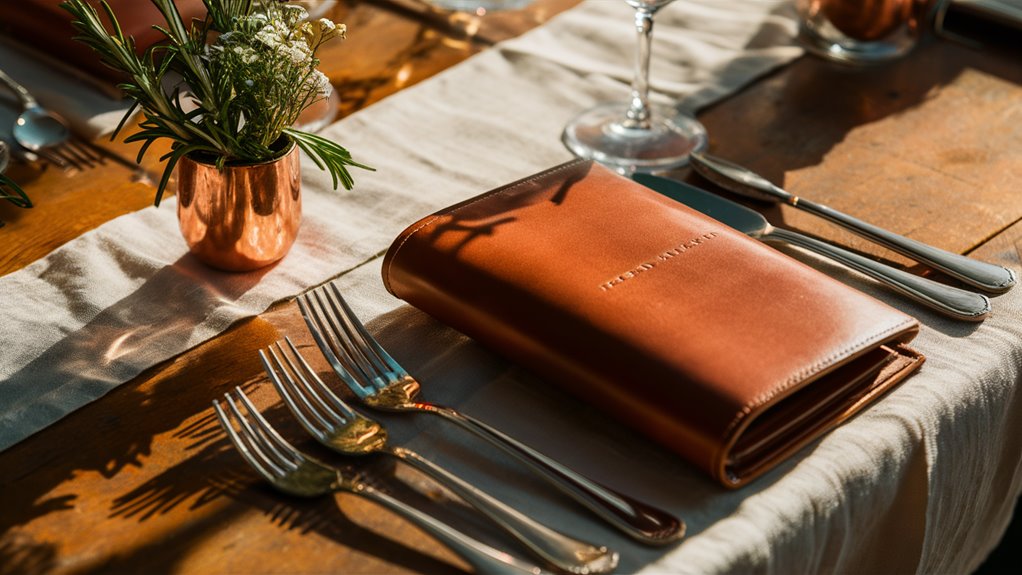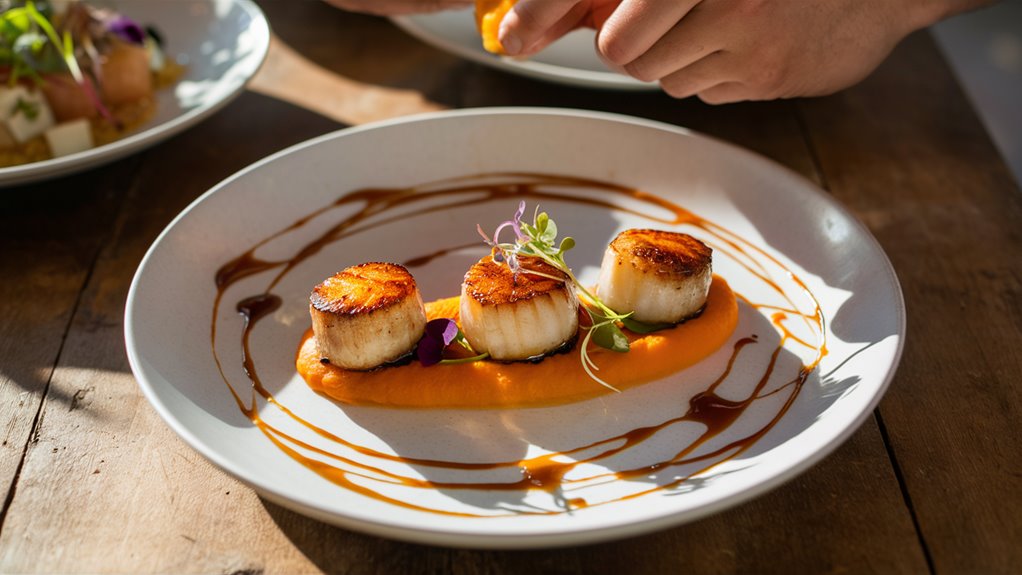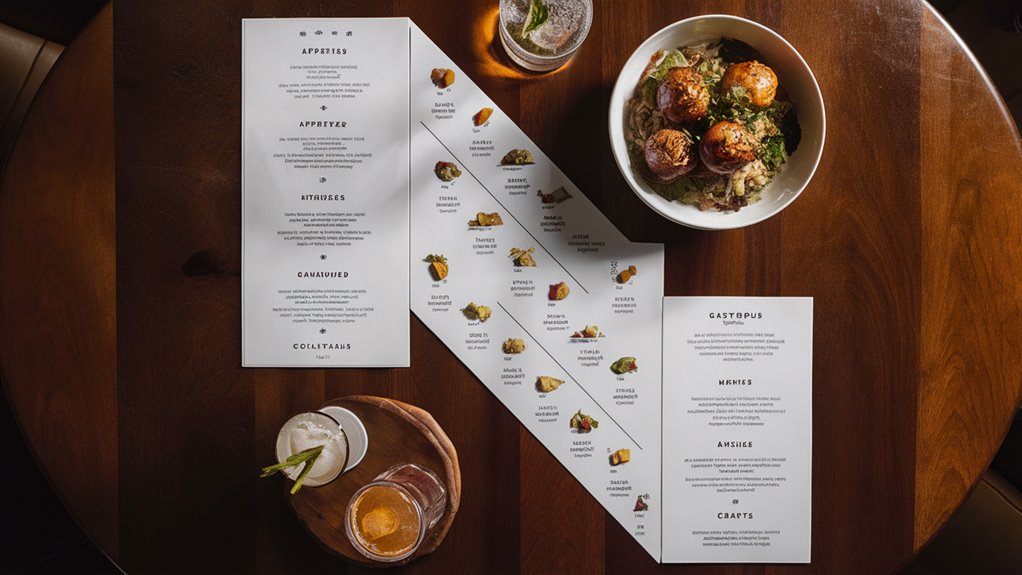
A Simple Plan for Making a Good Menu

Building a Menu That Feels Good
A well-made menu is a key part of a top restaurant, mixing good design rules with how guests think to boost both happiness and money made. The art of menu building is about making smart choices on where to place items and how to show them to help guide what people pick to eat.
Best Ways to Setup and Show Items
Menu layout work starts at the important upper-right corner, known as the “sweet spot” where guests look first. Using a Z-flow makes reading easy and points out items that make more money. Key design points include:
- 30% blank space for clear viewing
- Only two types of fonts for a neat look
- No dollar signs to make prices feel lower
- Smart use of color to catch eyes
- Good space between items to make reading easy
Writing Good Menu Words and Using Mind Tricks
Nice menu words make people feel a link with the food through:
- Tasty words that make you think of good food
- Stories of where the food comes from
- Show off cooking skills
- Changes with the seasons for new tastes
- Smart placing of items to push items that make good money
Getting More Money with Good Design
Make more money by using data to build a good menu:
- Put items that make good money in spots easy to see
- Name drops of star dishes
- Create levels of items that put the money makers on top
- Use time-based sales to push selling
- Keep smart number tricks to set good price points
This full way of making a menu brings about an unbeatable eating time while making sure both food joy and smart item show-offs are at their best.
Thoughts on Menu Making
Smart Layout and Seeing Key Things
Menu thought tricks use strong mind rules to change eating picks.
Smart item place is always in the upper right to match how eyes move, while show off tricks like boxes and darker spots make people look at items that bring in more money.
Tests show that erasing dollar signs from prices makes people less worried about cost and spend more.
Words That Work Like Magic
Menu making uses cool mind tricks with price set-ups, putting top items in key spots to shape what prices people will think of.
Words that pull you in boost sales by a lot, making strong feelings and seen value.
The smart set-up of these parts makes people happy and makes the restaurant win more money.
Colors and Choices
Color use is key in menu making, with red making people hungry and green saying it’s a healthy pick.
Choice keeping down to 7-10 items stops too much thinking and tired brains.
This well thought mix of seeing parts, price tricks, and mind pulls makes a top eating time while making the most money for the restaurant.
Key Menu Points:
- Smart item places in areas easy to see
- Luring hints through planned design parts
- Price starting tricks
- Words set just right
- Using colors for feelings
- Choice set-up fine-tuning
Smart Menu Design and Item Spots
Best Menu Layout for Most Money
Smart item place on restaurant menus uses tested ways that guide customer acts and boosts sales.
The menu’s best spots to see – mostly the *upper right corner* and *just below center* – get eyes first, making them top spots for star dishes and items that bring in good money.
Key View Spots and Seeing Setup
Menu building needs smart item placing in these sweet spots to make the most money.
Show off tricks like boxes, edges, and smart highlighting pull eyes to main dishes while keeping less costly choices in less seen spots.
The smart use of blank space stops too much to see and keeps the menu clear.
Z-flow Reading and Grouping
The Z-flow read rule is the base of smart menu layout. This natural eye move sets the best places: appetizers at the top, main meals in the middle, and sweet stuff at the end.
Menu kinds should have 7-10 items, making a good mix of choice and smooth running while stopping tired minds.
Grouping like items makes picking easier and ordering faster.
Writing Menu Words That Sell

Making Menu Words That Make People Buy
Menu words are big tools that change simple food into must-eat meals. Smart word picks and lively words make a feeling link that makes guests want to order.
How to Write Well
Start with main parts using clear, vivid terms. Change basic lists into must-try food – “herb-coated, fire-cooked chicken breast” does better than just “cooked chicken.”
Push how it’s made, top parts used, and what makes it special that set meals apart from others.
Words That Make You Feel
Add words that touch the senses that bring up feelings and body wants. Words like “crunchy,” “soft,” “made here,” and “from here” make clear pictures that make you hungry.
Stay away from hard words or too much word stuff that may turn diners away.
Tips for Good Writing
Keep words sharp and strong in just 15-25 words. Share needed info on food issues and what’s in it (GF, V, VG) where needed.
Be dead on in words to build trust and make sure guests are happy.
Main Parts of Good Menu Words:
- How it’s made clear
- Where the parts come from
- How it feels and tastes
- What’s in it now and from nearby
- Clear info on what’s in it
Colors and How Words Look in Menu Design
Picking Colors Smart for Menus
Color use is big in making menus and swaying how guests act.
Warm colors like red and orange make you want to eat and order more, while cool colors like blue and green can make you less hungry.
How the place feels should have just three colors to keep looks together and stop too much thinking.
Picking Words Right
Picking fonts needs thinking about both style and how well you can see them. Use a two-font way:
- Big heading font: Sets how the place feels
- Small words font: Makes sure things are clear
Fonts without feet like Helvetica look new and smart, while fonts with feet like Garamond give off a classic feel. Keep a least 12-point font size for easy reading in low light.
Contrast and How to Set It Up
Seeing order depends on smart use of contrast. Dark words on light backdrops give the best reading and getting to all.
Color blocks split up menu parts well and make star items stand out.
Using blank space makes a natural eye flow and less eye tiredness, while even space between things makes sure a professional look. The smart mix of how words look and colors makes a menu that pulls in guests and boosts how well things sell.
Smart Menu Pricing for Eateries
Looking at Costs and How Much You Make
Smart menu pricing needs a good balance between how much it costs and how much guests think it’s worth.
Start with figuring out all costs for each menu item, checking food costs, how much work costs, and what you need to run the place.
Good places keep food cost percentages between 28-35% of menu price, changing by what kind of place it is and where it stands in the market.
Smart Menu Building and Mind Tricks with Prices
Price start points boost how much you make through smart placing in menu best spots – areas where people look first.
Use charm prices ($19.95) for easy going places while keeping whole numbers ($20) for more fancy spots.
Create smart price start points with top offerings to make target items seem worth more.
Checking Competitors and Where You Stand
Do a deep check on competing prices covering many parts:
- How big servings are
- How good parts are
- How well you serve
- Where you stand in the market
Smart Moves with Prices
Keep pricing smart through:
- Regular checks on the market
- Changing with the seasons to push sales
- Adding what guests say
- Keeping prices the same everywhere
- Watching changes in food costs
- Matching prices for delivery
Watch and tweak how you price based on market moves, making sure you make money while keeping guests happy and standing well against others.
Guide to Planning Menus by the Season
When to Start Planning
Planning by the season means starting three months before to make the most of supplier links and make new dishes that go with the coming season.
This early start makes sure things go smooth and you have what you need when you need it.
How to Set Up Menus by the Season
Having four different menu changes through the year makes the most of fresh parts and how much you make:
Spring Menu Focus
- Fresh herbs and small greens more see
- Soft spring veggies
- Light, bright ways to make them
Summer Menu Points
- Food cooked on the grill
- Veggies that are best now
- Food that feels fresh
Fall Menu Parts
- Hard veggies
- Warm spice mixes
- Food that feels like home
Winter Menu Things
- Food cooked slowly
- Strong tastes
- Food for the holidays
- sound like a pro?
Keeping Menus Working Well
Keep 70% main dishes while changing 30% with the seasons to keep menus working well.
Change how much you serve with the seasons:
- Smaller servings when it’s hot
- Bigger servings when it’s cold
Watching Costs
Keep an eye on how prices change with the seasons and use smart moves with prices to keep target costs right.
Think about:
- What you can get when you can get it
- How much people want it
- What can change in getting it
- When things grow here


